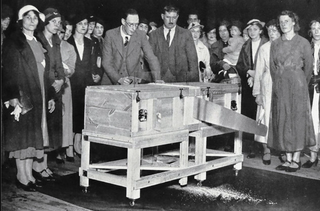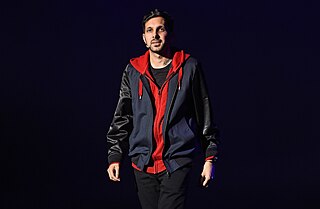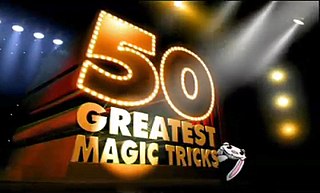Street magic falls into two genres; traditional street performance and guerrilla magic.
Contents

Street magic falls into two genres; traditional street performance and guerrilla magic.

The first definition of street magic refers to a traditional form of magic performance – that of busking. In this, the magician draws an audience from passers by and performs an entire act for them. In exchange, the magician seeks remuneration either by having a receptacle for tips available throughout the act (known in the parlance as a "trickle show"), or by offering a receptacle for tips at the end of the show. The term "passing the hat" comes from the practice of having the hat passed before the final trick is performed, as opposed to "bottling" the audience at the end of the performance.
Street magic most often consists of what has been referred to in the past as "hand" or "pocket" magic, sleight of hand. Whether card magic or magic performed with coins, balls, scarves, or rope, even occasionally mentalism, regardless of the props involved, the ability to draw and hold an audience is cited by contemporary practitioners as a skill of greater importance than the illusions themselves.
The famous Indian Mango Tree is an old and venerated trick as performed by street magicians of the past and while it is demonstrably not of the hand magic variety, it exemplifies the fact that even large stage sized illusions can be presented in the street. In the trick, the magician apparently plants a mango seed, covers it with a cloth, makes mysterious incantations and, removing the cloth from time to time successively shows a tree of various heights, up to two or three feet. The same effect was achieved by the Apaches. Instead of a mango seed, a yucca seed was planted and watered. Covering the seed with a rawhide animal skin, the seed would apparently root, grow and finally flower within the span of but a few minutes.
Anthropologists chronicle this form of street magic from approximately 3,000 years ago – and there are records of such performers across the continents,[ citation needed ] notably Europe, Asia/South Asia and the Middle East. While it is a very old performing style, its history is not particularly well documented in print. In his diary, Samuel Pepys mentions seeing magicians performing in this fashion and one can see street magicians in depictions by Hieronymous Bosch, William Hogarth, and Pieter Brueghel. Book XIII of Reginald Scot's Discoverie of Witchcraft (1584) describes magic tricks of the type performed by buskers in the 16th century.

New York based artist and magician Jeff Sheridan is regarded as one of the pre-eminent U.S. street magicians to emerge from the surge in street performance artistry which began in the late '60s. He authored the 1977 book, Street Magic, taught Jeff McBride and allegedly was one of the performers who inspired and taught the young David Blaine after Blaine saw Sheridan perform in Central Park.
Yorkshire Egg Magic is a long practised form of traditional street magic in the UK. [1]
More recently, other performers have garnered accolades from the magic community for their contributions to the art. Jim Cellini (a.k.a. Richard Sullivan) has been a full-time street performer since the 1970s and has published a book (Cellini: The Royal Touch) and DVDs (The Art of Street Performing, volumes 1–3) on the subject. Gazzo Macee (a.k.a. Gary Osborne) has been a full-time street performer since the 1980s and has published a booklet ("The Art of Krowd Keeping" written for Gazzo by Danny Hustle and Jim Wells) [2] and DVD (Street Cups) on the subject. Eric Evans has been a full-time professional since the 1990s and co-wrote – along with Nowlin Craver – a book on the subject (The Secret Art of Magic).
The second category is more appropriately called "guerrilla magic" [3] It is a relatively recent style of performing magic illusions where the magician performs a single trick or two in a public space (such as on a sidewalk) for an unpaying audience. The desired effect of this "hit and run" style of magic is to give the audience a feeling that what they are seeing is impromptu, unrehearsed, and experimental.
This style of "street magic" is associated with David Blaine (who popularized the term) and more recently, Criss Angel, Derren Brown and Cyril Takayama. The format was developed to play well on television beginning with the 1997 ABC television special David Blaine: Street Magic. Many magicians respect Blaine's choice of material and give him credit for creating an image of the contemporary magician distinct from other magicians in recent television history, such as David Copperfield or Doug Henning. However, magic historians, such as Jamy Ian Swiss note that "guerrilla magic" is primarily associated with only a few individuals who perform on television and certain magic dealers who sell effects to amateur magicians who watch these programs. [4] Eugene Burger opined to Jamy Ian Swiss "On one level it's the ultimate trivialization of magic: accosting strangers on the street." [4]

The Balducci levitation is a levitation illusion first described by Ed Balducci. Its inventor is unknown. It is an impromptu magic trick, which has been popularized by many magicians, such as David Roth, Paul Harris, and David Blaine.

The cups and balls is a performance of magic with innumerable adaptations. Street gambling variations performed by conmen were known as Bunco Booths. A typical cups and balls routine includes many of the most fundamental effects of magic: the balls can vanish, appear, transpose, reappear and transform. Basic skills, such as misdirection, manual dexterity, sleight of hand, and audience management are also essential to most cups and balls routines. As a result, mastery of the cups and balls is considered by many as the litmus test of a magician's skill with gimmick style tricks. Magician John Mulholland wrote that Harry Houdini had expressed the opinion that no one could be considered an accomplished magician until he had mastered the cups and balls. Professor Hoffman called the cups and balls "the groundwork of all legerdemain".
Sleight of hand refers to fine motor skills when used by performing artists in different art forms to entertain or manipulate. It is closely associated with close-up magic, card magic, card flourishing and stealing. Because of its heavy use and practice by magicians, sleight of hand is often confused as a branch of magic; however, it is a separate genre of entertainment and many artists practice sleight of hand as an independent skill. Sleight of hand pioneers with worldwide acclaim include Dan and Dave, Ricky Jay, Derek DelGaudio, David Copperfield, Yann Frisch, Norbert Ferré, Dai Vernon, Cardini, Tony Slydini and Helder Guimarães.
The Chinese linking rings is a classic of illusion magic. In the traditional effect, solid metal rings appear to link and unlink, pass through each other, and form chains and other complex patterns and configurations. The rings may even be handed out to audience members for examination. Sometimes an audience member is invited onto the stage to perform alongside the magician as part of a "do as I do" routine.

Coin magic is the manipulating of coins to entertain audiences. Because coins are small, most coin tricks are considered close-up magic or table magic, as the audience must be close to the performer to see the effects. Though stage conjurers generally do not use coin effects, coin magic is sometimes performed onstage using large coins. In a different type of performance setting, a close-up coin magician will use a large video projector so the audience can see the magic on a big screen. Coin magic is generally considered harder to master than other close-up techniques such as card magic, as it requires great skill and grace to perform convincingly, and this requires much practice to acquire.

P. T. Selbit (1881–1938) was an English magician, inventor and writer who is credited with being the first person to perform the illusion of sawing a woman in half. Among magicians he was known for his inventiveness and entrepreneurial instinct and he is credited with creating a long list of successful stage illusions.

Mentalism is a performing art in which its practitioners, known as mentalists, appear to demonstrate highly developed mental or intuitive abilities. Performances may appear to include hypnosis, telepathy, clairvoyance, divination, precognition, psychokinesis, mediumship, mind control, memory feats, deduction, and rapid mathematics. Mentalists perform a theatrical act that includes effects that may appear to employ psychic or supernatural forces but that are actually achieved by "ordinary conjuring means," natural human abilities, and an in-depth understanding of key principles from human psychology or other behavioral sciences.

Sawing a woman in half is a generic name for a number of stage magic tricks in which a person is apparently sawn or divided into two or more pieces.
The bullet catch is a stage magic illusion in which a magician appears to catch a bullet fired directly at them — often in the mouth, sometimes in the hand or sometimes caught with other items such as a dinner plate. The bullet catch may also be referred to as the bullet trick, defying the bullets or occasionally the gun trick.
Paul Kieve is an English professional illusionist and whose consulting work for both stage and screen has contributed to changing how magical special effects in productions are approached. He is the only illusionist ever to have won a New York Drama Desk award. He created the illusions for the 2014 Kate Bush concert Before the Dawn.
Jeff Sheridan is an American magician who started his career by specializing in street magic. Sheridan began working in New York City around 1967. He studied briefly at the School of the Visual Arts in NYC in the late 1960s. He authored the 1977 book, Street Magic, An Illustrated History of Wandering Magicians and Their Conjuring Arts. The book was coauthored by Edward Claflin.
This timeline of magic is a history of the performing art from B.C. to the present.
Needle-through-arm is a magic illusion that was created by Bruce Spangler and later popularized by comedy actor/magician Harry Anderson. The trick can be performed as part of either a stage magic or a parlor magic routine. As the name would suggest, needle-through-arm relies on shock value to have a comedic effect.

Jamy Ian Swiss is an American magician, author, speaker, historian of magic, essayist, book reviewer, and scientific skeptic. He is known for sleight-of-hand with playing cards.
A magician's assistant is a performer in a magic act who is not billed as the magician or principal name in the act. The role of an assistant can include holding the props that are used by a magician, shifting props onto and off the stage, and serving as a living prop in illusions that involve manipulation of the human body. Other aspects of the role can include dancing or acting as visual ornamentation, sometimes for simple aesthetic purposes and sometimes to misdirect audience attention. The figure of the glamorous female assistant has become a stereotype or icon in art, popular media and fiction.

Steven Frayne, better known by his stage name Dynamo, is a British magician born in Bradford, West Yorkshire. His television show Dynamo: Magician Impossible ran from July 2011 to September 2014, and saw him win the Best Entertainment Programme award at the 2012 and 2013 Broadcast Awards. Dynamo has toured the world, and his Seeing Is Believing arena tour was seen by over 750,000 people across the UK, Australia, South Africa and New Zealand.

Magic, which encompasses the subgenres of illusion, stage magic, and close up magic, among others, is a performing art in which audiences are entertained by tricks, effects, or illusions of seemingly impossible feats, using natural means. It is to be distinguished from paranormal magic which are effects claimed to be created through supernatural means. It is one of the oldest performing arts in the world.

The Magicians is a British talent show, first broadcast throughout January 2011 on BBC One.

Gary 'Gazzo' Osbourne is a British street magician. An expert in cons and scams, he moved in the 1980s to the US, where he befriended Walter Irving Scott. He is Scott's only pupil and the only person with whom Scott entrusted his biography and life's work at card cheating and sleights.

50 Greatest Magic Tricks is a one-off list show that was produced by Objective Productions for Channel 4. The programme counted down the fifty greatest magic tricks, as voted for by members of The Magic Circle. The illusion at number one was Death Saw by David Copperfield. The show was presented by British comedy duo Adam and Joe, who also wrote and narrated the programme. The show was first broadcast on Channel 4 on 6 May 2002.